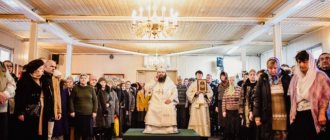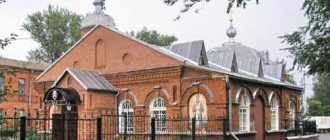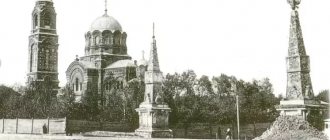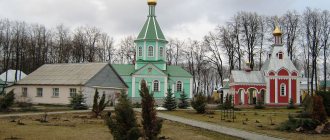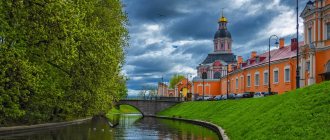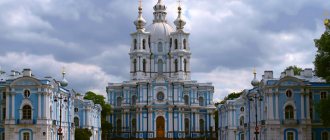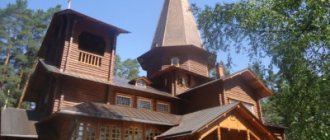The construction of the church was associated with the founding of a new Necropolis in the northwestern part of the northern capital. At that time, it was a distant outskirts of St. Petersburg, where there was a single church in honor of the Annunciation of the Blessed Virgin Mary. By about 30 years of the 19th century, this area had turned into one of the fashionable holiday suburbs. At the beginning of the 20th century, this small outskirts of St. Petersburg became part of the city.
| Temple of Seraphim of Sarov at the Seraphim Cemetery | |
| A country | Russia |
| City | Saint Petersburg |
| Year of foundation | 1906 |
| Website | https://serafimovskiy.ru |
| Abbot | Archpriest Nikolai Konkov |
The Temple of Seraphim of Sarov at the Seraphimovskoye Cemetery is one of the most famous and revered churches in St. Petersburg. In 2012, 105 years passed since the consecration of this temple.
“...In the 90s, I first saw the rector (of the Seraphim Church), Father Vasily, always polite and attentive...
people were drawn to him, talked about their sorrows and joys, the holy father always listened to everyone attentively and gave advice...
he left us in 2007, but even now his entire grave is covered in fresh flowers, parishioners constantly come to visit their priest...”
Source: Otzovik
Temple of Seraphim of Sarov at the Seraphim Cemetery. Photo: pilgrimnic.org
Initially, the Church of Seraphim of Sarov was assigned to the Annunciation Church
At that time, the Annunciation Church had already ceased to accommodate a fairly large parish, and the church cemetery had become quite crowded for new burials of people.
1905
this year a decision is made to build the St. Seraphim Church
In 1905, Metropolitan Anthony of St. Petersburg and Ladoga decided to build a wooden three-altar church on an allocated plot of land.
This temple was originally supposed to be assigned to the Church of the Annunciation, and it was supposed to be illuminated in the name of St. Seraphim of Sarov.
Metropolitan Anthony of St. Petersburg and Ladoga decided to build a new church in honor of Seraphim of Sarov. Photo: iknigi.net
It was also ordered to build a cemetery on this site, also with its name Serafimovskoye.
The idea to consecrate the temple in honor of St. Seraphim of Sarov arose under the impression of the glorification of the elder in 1903, when this happened with a large crowd of people.
Then one of the metropolitans wrote that the holy church decided to come to the celebration of its own priest, that is, Saint Seraphim of Sarov.
Seraphim Church was the first to be dedicated to Father Seraphim
Elder Seraphim of Sarov
At that time, the Seraphim Church became the first to be dedicated to Father Seraphim. Funds were collected not only from parishioners, but also from major benefactors.
The Church of Seraphim of Sarov at the Seraphimovsky Cemetery is a very interesting and quite rare example of wooden church architecture of the 20th century for St. Petersburg.
Seraphim Church became the first church to be consecrated in honor of the Holy Father Seraphim of Sarov. Photo: hranitel.club
It is believed that the architect of this temple was Alexander Fedorovich Baranovsky. Nikolai Nikitich Nikonov helped him in the construction of the temple architecture.
July 25, 1906
on this day the foundation of the Seraphim Church was founded
On July 25, 1906, the foundation stone of the temple took place; it was performed by the dean of the Savior Semyonovskaya Church, Archpriest Nikolai Stravinsky. The construction of the church was carried out by a peasant from the Pskov province named Vasiliev.
Schedule of services[edit]
On weekdays at 10:00 - Liturgy; prayer service and memorial service, at 17:00 - vespers.
On Sundays, twelve days, great and patronal holidays, two Liturgies are served: early at 7:00 with litia, late at 10:00 with requiem, and at 13:00 custom prayers.
On the eve of the twelve, great, patronal feasts and Sundays, an all-night vigil is celebrated at 17:00.
On Sunday evenings at 17:00 Vespers is celebrated with the reading of the Akathist to St. Seraphim of Sarov.
On Wednesday evenings at 17:00 Vespers is celebrated with the reading of the akathist to St. Nicholas the Wonderworker.
Every day during the day the sacraments of confession, baptism, wedding and church services are performed at the request of the parishioners.
In 1907, the Church of Seraphim of Sarov at the Seraphim Cemetery was consecrated
Memorial Day of Seraphim of Sarov
According to many sources, it is known that the church was built in just 87 days. In 1907, on March 1, Archpriest Nikolai Stravinsky illuminated the Church of Seraphim of Sarov at the Seraphimovsky cemetery.
Until about 1923, the Church of St. Seraphim was assigned to the Church of the Annunciation, but then after that it gained its independence.
In 1907, the church in honor of Seraphim of Sarov was consecrated
The first rector of this church was priest Pavel. It was he who became the author of a complete historical description of the entire Seraphim cemetery. Later, the Seraphim Temple was closed.
It was used as a warehouse and then a distribution center for receiving the dead. In 1942, on April 28, the temple was handed over to the church community, and it was revived.
April 28, 1942
on this day the temple was returned to the community
An amazing event happened then. The news of the lifting of the blockade of the city sounded through the church bells, which rang for several days without ceasing. At different periods of time, the abbots of the Seraphim Church changed.
Bibliography
- Pashsky Pavel Vasilievich.
Description of the structure of the Serafimovsky cemetery in Novaya Derevnya, St. Petersburg district / Comp. according to the church documents by the priest of Blagoveshch. Novoderev. Church of Pavel Pashsky. - St. Petersburg: Typolytography Strashuner, 1907. - 31 p. - V.I. Saitov (compiler), on assignment.
Vel. Book Nikolai Mikhailovich. St. Petersburg necropolis, volume I (A-G), volume II (D-L), volume III (M-R), volume IV (S-Fita). - St. Petersburg, printing press. M.M. Stasyulevich, 5 lines. V.O., no. 28, 1912-1913. - St. Petersburg diocese, 2009. Directory / archpriest. Alexander Sorokin. - St. Petersburg: “Incense”, “Diskus Media”, published. department of the St. Petersburg diocese, 2008. - 496 p. — (“Dioceses of Russia”, 1st issue, vol. I). — ISBN 5-86983-095-8, 978-586983-042-5.
- A. I. Andreev.
Serafimovskoye Cemetery // Alexander Valerievich Kobak, Yuri Minaevich Piryutko: Historical cemeteries of St. Petersburg. — 2nd ed., revised. and corr. - M.: Tsentrpoligraf, 2011. - ISBN 978-5-227-02688-0.
From 1981 to 2007, the rector of the temple was Archpriest Vasily Ermakov
From 1981 to 2007, the rector of the church was Archpriest Vasily Ermakov - he was one of the most famous and honored clergy of the diocese. It is believed that many people from all over Russia came to this man for advice.
This man was born in 1927 in the city of Bolkhov, Oryol region. His family were believers from the very beginning.
Archpriest Vasily Ermakov. Photo: xn--b1algoccq.xn--p1ai
A little later, in 1943, Vasily was sent to a camp from the occupied city. In the camp where he was taken by the Germans, he met the future Patriarch Alexy II.
In 1949, Ermakov graduated from the newly revived theological seminary, and 4 years later he graduated from the academy.
1981
this year Archpriest Vasily Ermakov has been appointed rector of the church
After graduating from the academy, he was ordained to the priesthood. At first he served in the St. Nicholas Cathedral, and then in the Trinity Church. After which, in 1981, he was sent to serve as rector at the Seraphim Church.
Vasily Ermakov died on February 3, 2007, when he turned 80 years old. He was buried at the Seraphimovskoye cemetery.
Currently, the temple at the Seraphim cemetery has become one of the most favorite places
Currently, the temple at the Serafimovskoye cemetery in St. Petersburg has become one of the most favorite places of believers. Everyone who has visited this church at least once says that there is some amazing prayerful spirit here.
People prayed earnestly under the arches of this wonderful temple. They also prayed when there were rather difficult times in the church.
Many people gather here, at the Church of Seraphim of Sarov in St. Petersburg during patronal holidays. Photo: upload.wikimedia.org
As of 2007, this strong and friendly parish already numbers several hundred people. This parish is headed by Archpriest Nikolai Konkov, who has served there since 1984.
1984
from this year, the mitred archpriest Nikolai Konkov is rector of the church
When he just graduated from the theological seminary and academy, and then graduate school, he was immediately ordained to the priesthood, after which he was sent to serve in the Seraphim Church.
Links[edit]
- Temple of St. Seraphim of Sarov at the Seraphimovsky cemetery. General information
- CHURCH OF THE HOLY REVEREND SERAPHIM OF SAROV at the Seraphim Cemetery. reference Information
- Temple of Seraphim of Sarov at the Seraphim Cemetery
- Saint Petersburg. Church of Seraphim of Sarov at the Seraphim Cemetery. Photos
- Website about Archpriest Vasily Ermakov
- Archpriest VASILY ERMAKOV. Vkontakte community
- Our spiritual father is Archpriest Vasily Ermakov
- Who do you love more? In memory of Archpriest Vasily Ermakov
In 2009, Patriarch Kirill of Moscow visited the Church of St. Seraphim
In 2009, His Holiness Patriarch Kirill of Moscow and All Rus' visited the Church of St. Seraphim of Sarov in St. Petersburg. During this visit, he awarded the rector of the temple with the Order of St. Seraphim of Sarov, 3rd degree.
Archpriest Nikolai has been serving in the church for more than 25 years. Also, His Holiness Patriarch Kirill served a litiya at the grave of his maternal grandfather, who was also buried at the Seraphim cemetery.
Patriarch Kirill of Moscow during his stay in the Church of Seraphim of Sarov. Photo: 151722.selcdn.ru
It is also worth noting that in 2012, the church at the Seraphimovsky cemetery was visited by His Eminence Vladimir, Metropolitan of St. Petersburg and Ladoga. He very often attended divine services and served prayer services, especially on patronal feast days.
Icons
Near the main choir of the temple there is the main shrine - the icon of the Sarov Seraphim. Here lie parts of the relics, the coffin and the stone where the monk performed his prayer, which lasted a thousand days and nights. Legend has it that the shrines went to the church as donations from the Ivanov spouses, who learned about the construction of the temple.
On the left side of the church is the “Tenderness” icon, depicting the Mother of God. Another name for the image is “Joy of All Joys.” As eyewitnesses testify, in the winter of 1833, in the cell of Father Seraphim, novices found the saint kneeling in front of this icon.
Further on the right side is the icon of the Kazan Mother of God. The shrine appeared in 1579 in Kazan. In 1811, the Kazan Cathedral was built especially for the icon, where it remained for almost 100 years. In 1904, thieves entered the church and stole the shrine. Soon the robbers were found, but the miraculous icon disappeared without a trace.
On the left side, near the northern entrance, there is an icon of St. Nicholas, created in oil at the beginning of the 20th century. The shrine stands on the floor in a specialized icon case (carved in the shape of a grapevine).
Near the icon of St. Nicholas the Savior there is a memorial plaque made of brass. It depicts St. Nicholas the Wonderworker. The plaque was created in memory of the soldiers and officers from the Oryol infantry regiment who died on the San River.
On the left side at the entrance to the temple is the “Sign” icon, created at the beginning of the 20th century. In the vastness of Rus', the original version of the shrine was called “Incarnation”, and it was known since the 11th century.
Immediately on the previous shrine is the icon of the Mother of God of Smolensk. Initially, the image was located within the walls of the Church of the Annunciation. After the closing of the last one, the icon was transferred to the Church of Seraphim of Sarov.
On the opposite side to the right is the icon of the Mother of God of Tikhvin. The image was painted in oil on wood at the end of the 19th century. The icon was originally created according to the image that appeared over the waters of Lake Ladoga in 1383.
In the temple there is an icon of the “Seeking of the Lost” of the Mother of God. The image helps people who have lost hope of salvation, those who feel that life is irrevocably over. The Mother of God helps such lost souls find the right path.
On the opposite side of the Crucifixion is the “Candlemas” icon. The holy image is one of the most ancient within the walls of the temple. It dates from the mid-18th century.
Within the walls of the temple there is an icon of the “Kazan-Romanov” Mother of God. The image was created in 1888 in honor of the miraculous rescue of Alexander 3, who survived the train accident. During the destruction of the imperial palace at the beginning of the 20th century, the icon was saved by Stepan Nikitich, who worked as a manager. In subsequent years, the shrine was hidden in his family until it was transferred to the temple of Seraphim of Sarov.
Since 1987, repair and restoration work began in the temple
In 1987, it was decided to produce small paintings. Much has been replaced with mosaic images. In 1980, a one-story building was built to the north of the church, where a refectory and Sunday school were located.
A little later, with donations from parishioners and donations from the rector of the temple, a major overhaul of the temple was carried out. In 2002, they decided to renovate the facades and replaced the mosaics.
2002
that year the major and cosmetic decoration of the temple was completed
In the same year, a major renovation of the wooden one-story building was carried out. Currently there is a church shop on this site.
Also, the rector, Archpriest Nikolai, organized work to replace the interior decoration of the walls of the central part and outside. Some of the icons were also restored. It is also impossible not to say about the cemetery, which is located next to the temple.
Many famous people are buried at Serafimovskoye Cemetery
Such famous people as Archpriest Stefan, priest Nikolai Lomakin, priests Ivan, Anatoly Kanyuk, church historian Uspensky, Archbishop of Brussels and Belgium Vasily and many others are buried at the Serafimovsky cemetery.
Artists, scientists, priests, naval commanders and many others are buried at the Serafimovskoe cemetery. Photo: im3.turbina.ru
It is believed that 10,000 Leningraders were buried at the Serafimovskoye cemetery during the siege. They said that dead people were laid in 4 rows and covered with earth.
To the left along the central road are the graves of naval commanders who were buried here in 1943. They also installed a tombstone. There are also people who died in plane crashes here.
In 1991, there was a fire at the Leningrad Hotel - it was one of the worst fires in St. Petersburg of the 20th century. A lot of people died, they were also buried at the Serafimovskoye cemetery, and a monument was erected to them.
A memorial to those killed was erected at the Serafimovskoye cemetery. Photo: pkokprf.ru
A lot of famous people are buried at the Serafimovskoye Cemetery, including artists and scientists, as well as military leaders, philanthropists and trustees, that is, those people whose services to the fatherland are so high.
During divine liturgies, people who died for our homeland, for our fatherland during the war, blockade, as well as people who died in plane crashes, are remembered in church every liturgy and prayers are read for them.
Saving the Romanovs: an illusion or missed opportunities?
Compiled by: Deacon Alexander Bertash. Publishing house "Agat". Saint Petersburg
CHURCH IN
THE NAME OF THE REVEREND
SERAPHIM OF SAROV
Compiled by: Deacon Alexander Bertash
Publishing house "Agat"
The Church in the name of St. Seraphim of Sarov at the Serafimovskoye cemetery near the Staraya Derevnya metro station is now one of the most famous and revered churches in the northern capital, although it has not yet celebrated its centenary. The construction of the temple is associated with the founding of a new necropolis on the northwestern outskirts of the northern capital, in the “Old Village” area, where the only parish church for a long time was the Church of the Annunciation (1765, completely rebuilt in stone in 1803-1809). It was erected by Chancellor A.P. Bestuzhev-Ryumin, owner of the local lands in the middle. XVIII century, for its peasants, who laid the foundation for the settlements of Staraya and Novaya Derevnya. Then it was the distant outskirts of St. Petersburg. By the 30s of the 19th century, the area had turned into one of the fashionable dacha suburbs of St. Petersburg. Many representatives of the capital's aristocracy, artists, writers, and poets lived here. A.S. knew these places well. Pushkin - in 1833 and 1835, his family rented a dacha near the Black River in the summer. The graveyard at the Church of the Annunciation is described in the poem “When outside the city, thoughtfully, I wander...”.
At the beginning of the 20th century, this area became part of the city. The Annunciation Church could no longer accommodate the expanded parish, and the Annunciation Cemetery by the beginning of the 20th century. became too crowded for new burials. In 1903, at the request of the clergy and local residents, a plot of church land of 27 dessiatines was allocated. 551 sq. soot for a cemetery and a wooden church. On June 23, 1903, the Synod gave the appropriate permission, but the parish did not immediately take advantage of it.
Only on January 2, 1905, the construction commission again turned to Metropolitan Anthony (Vadkovsky) of St. Petersburg and Ladoga with a request to build a temple, stipulating its consecration in the name of St. Seraphim of Sarov, as well as the name of the cemetery itself Serafimovsky. The idea of consecrating the temple in the name of St. Seraphim (1760-1833), whom Archbishop Filaret (Gumilevsky) of Chernigov called “the greatest ascetic of piety of recent times,” apparently arose under the impression of the recent glorification of the saint. The canonization in 1903, after many years of popular veneration, took place in front of a huge crowd of people. Metropolitan Veniamin (Fedchenkov) wrote: “Holy Rus' came to the celebration of its saint, dear one, ‘our father’.” Seraphim Church became one of the first churches dedicated to the people’s beloved saint.
While the construction of the church was underway, the cemetery had already begun to operate and serve primarily as a burial place for the poor. The first burial took place on May 28, 1905. Even less privileged was the Public (Peasant) Cemetery, which occupied an area of 3 hectares along modern Dibunovskaya Street. During the Great Patriotic War, the personnel of the Commandant's airfield were buried there. The cemetery was razed in the 1950s. during the development of the Old Village. Even earlier, in the 1940s, the Annunciation Cemetery at the church, which by that time had already been closed, was also destroyed. The Serafimovskoye cemetery, which has survived to this day, is thus part of a large urban necropolis, which became a victim of the blasphemous attitude of godless authorities towards the memory of their deceased ancestors.
Let us turn to the history of the construction of the Seraphim Church. In the spring of 1905, the final decision was made to build a wooden three-altar church attached to the Church of the Annunciation, and fundraising began from parishioners and benefactors. Nikolai Nikitich Nikonov (1849-1918), a famous master of the Russian style, diocesan architect (1893-1906), was usually indicated as the author of the structure. However, the design drawings of the temple, corresponding to the type of construction, were only endorsed by N.N. Nikonov. They are signed by the architect Alexander Fedorovich Baranovsky (1872-?), the author of a number of apartment buildings in the city (the nature of his signature coincides with the autographs on the designs of the houses he built). Participation of N.N. Nikonov was limited to helping draw up the plan; perhaps he made changes to the original project: replacing the belfry with a bell tower, adding an extension to the northern wall of the altar, constructing crypts under the church. He supervised the construction.
The foundation stone for the temple was laid on July 25, 1906 by the dean, rector of the Spaso-Senovskaya Church, Archpriest N.A. Travinsky. The construction was carried out by the peasant of the Pskov province P.V. Vasiliev. By October - in 87 days, it was completed. March 1, 1907 Fr. Nikolai Travinsky consecrated the temple. The construction cost 20,000 rubles, of which 15,000 were loaned by the Synod in installments for 10 years. The church is located in the depths of the Serafimovsky cemetery, east of the central (formerly Serafimovskaya) alley, crossing the cemetery from north to south. The western facade with the main entrance faces Birch Alley.
The church is one-story, log, wooden. The building was built according to the traditional three-part scheme for Russian church architecture. In plan, it consists of three rectangles adjacent to each other. The widest western part includes a vestibule, above which there is a bell tower, a refectory and side chapels; the middle part is a central quadrangle with side porches. The narrower eastern part consists of the apse and surrounding service spaces, including the sacristy. The volume of the building is distinguished by a high quadrangle and a bell tower, completed with tetrahedral tents with onion-shaped domes on drums. The carved decoration of the facades is in the Russian style. The Church of St. Seraphim of Sarov is an interesting and rare example of wooden church architecture for St. Petersburg from the early 20th century, reflecting the traditions of stone architecture of the Russian style. At the church there was a chapel - a mortuary, and a gatehouse-office. Opposite the church is a wooden chapel-tomb for the Sinitsyns, built in the 1910s.
The chapels of the three-altar church (the right one - in the name of the holy martyr Queen Alexandra, the heavenly patroness of the Empress Alexandra Feodorovna, now glorified as a saint; and the left one - in the name of the Intercession of the Most Holy Theotokos) are separated from the main volume of the temple so that it is possible to simultaneously serve the liturgy and perform the funeral service or make other requests.
Oak thrones - a gift from A.V. Balyavin, a large Gospel in a gilded silver frame with bas-reliefs of the Resurrection of Christ, the Evangelists and the Nativity of Christ - A.I. Sekunova; altar cross and small Gospel - A.D. Shershova.
The altarpiece “The Appearance of the Savior to Hierodeacon Seraphim” (artist Annushkin; lost) was donated by the merchant F.M. Minaev, wooden altar cross and bronze seven-branched candlestick - personal honorary citizen, owner of the typolitographic paints and varnishes factory Avraamy Ivanovich Shadrin. The chandelier, tabernacle and liturgical vessels were donated by A.D. Smirnov, velvet banners - S.M. Burov. The temple is decorated with a highly artistic carved iconostasis in the Russian style, created with funds allocated by the merchant-leatherworker, hereditary honorary citizen Alexander Alexandrovich Nikolaev “for the health of Alexander, Natalia and their children.” 11 icons on zinc were donated to the iconostasis “about the health of Michael, Anna and their children” (the icons have not survived) by a personal honorary citizen, merchant Mikhail Nikolaevich Kolchin. Signs commemorating A.A.'s gifts. Nikolaev and M.N. The colchin is attached to the altar side of the iconostasis.
After the revolution, until December 15, 1923, the temple continued to be affiliated with the Annunciation Church. The first rectors were priests Jacob Zhuravsky and Pavel Pashsky, the author of the most complete historical description of the Seraphim cemetery. Then, until October 2, 1937, the church passed to the radical renovationist group “Living Church”, its rector was the notorious leader of the group “protopresbyter” Vladimir Krasnitsky. Father Pavel Pashsky told his parishioners before leaving that they had nothing more to do in the “red” church. On the night of August 9-10, 1925, the icons of the main iconostasis and the altarpiece were stolen. By February 1927, new icons were painted on canvas, which have survived to this day.
In October 1933, the authorities removed all 4 bells from the belfry. After the death of Krasnitsky in November 1936 (who was buried in front of the entrance to the church), Archpriest Jacob Zhuravsky, who had deviated from the Church of the Living Church (who was shot in 1937), also became rector. Since October 1937, the temple belonged to the renovation movement. In the same year, the Annunciation Church was closed (returned to the Church in 1992, services resumed in 1997, the building was restored in 2003). Seraphim Church was closed only during the blockade winter of 1942: from January 22 to April. The district council set up a “distribution warehouse for receiving the dead” there. All property was “dumped at the altars.” On April 28, 1942, the church was transferred to the community of the Patriarchal Church and revived. When the news came about the lifting of the blockade, the revived church bells rang for two days.
A number of shrines are now preserved in the altar. The Gospel in a silver setting weighing 5 pounds 32 spools was printed in 1859 and 4 years later donated to the Annunciation Church by landowners Mikhail Vasilyevich and Elisaveta Vasilievna Shishmarov. A silver liturgical set (two cups, a paten, an asterisk, a spoon) from 1914 is dedicated to the memory of St. John of Kronstadt, about which there is an inscription on the cup and paten. The altarpiece depicts the Holy Trinity. The icon of the 12 holidays is skillfully carved from bone.
Among the current icon decoration of the temple, the icon of St. Seraphim of Sarov stands out in front of the right choir in an artistic icon case with particles of relics, a mantle, “finger from the coffin” and the coffin of the saint, the stone on which he prayed for 1000 days (a gift from Metropolitan Anthony /Melnikov/). List with cell
icons of the saint - the image of the Mother of God "Tenderness" - in front of the left choir. One of the three icons of the twelve feasts, according to legend, was donated to St. Righteous John of Kronstadt.
The icons of the Mother of God of Kazan and St. Nicholas the Wonderworker in carved notes on the choirs are a gift from the Ivanov family. From the Church of the Annunciation come the images in the carved icon cases on the walls of the refectory part of the temple: the Mother of God of Tikhvin, “Recovery of the Lost,” “The Sign”; Saint Nicholas. On the left is the Smolensk icon of the Mother of God from the Annunciation of the Church, in its current form corresponding to the style of the second half of the 19th century, but, according to legend, painted in the 17th century. and brought by the first builders of St. Petersburg from Smolensk, the prayer in front of it subsequently helped to get rid of the cholera epidemic, in memory of which a religious procession was held annually with the icon on the day of its celebration, July 28. Particularly valuable is the lifetime image of St. Seraphim of Sarov on the southern wall, donated by D.S. Bogachev, a disciple of the monk and the first biography writer Ivan Tikhonov Tolstosheev (later abbot Joasaph, in the schema Seraphim). The two clergy icons of Saints John Chrysostom and Mary of Egypt on the southern wall are by the artist Grebennikov (the first of them is signed). In the same part there are icons of the Mother of God of Kazan and the Great Martyr Panteleimon. The image of the Presentation on the western wall in the central part is the oldest in the temple (no later than the middle of the 18th century). Nearby is an icon of St. Tikhon of Zadonsk. The icon of St. Nicholas on a brass board (in front of the left choir) is dedicated to the memory of 163 Russian soldiers of the 36th Infantry Oryol Field Marshal Prince of Warsaw Count Paskevich-Erivan Regiment who fell at the river. San October 6-10, 1914. Among them were captains Fritz Fritsevich Krumin and Nikolai Nikolaevich Ilyinsky, 2 second lieutenants, 22 non-commissioned officers, 34 corporals and 105 privates. On the board are the words: “There is no greater love than that who lays down his life for his friends. Everlasting memory".
In the Intercession chapel there are icons of the Savior Pantocrator, the Mother of God: Lesninskaya, “Joy of All Who Sorrow”, Smolenskaya; icon “Appearance of the Mother of God to St. Sergius of Radonezh”; icons of saints: John the Baptist, St. Nicholas, Prophet Jonah. In the Alexandria chapel there is a copy of the miraculous Kazan Icon of the Mother of God, which belonged to Grand Duke Mikhail Alexandrovich (transferred in the 1960s by the family of Hieromonk Mitrofan). Here is the image of the Mother of God “Quiet my sorrows.” Two-tiered bronze chandeliers have been preserved in the main and side aisles.
In 1987, the picturesque images of events from the life of St. Seraphim on the outer western facade of the temple were replaced by mosaics. In the early 1990s. To the north of the church, a brick one-story clergy building was built, where refectories and a Sunday school are located. In 2000, with donations from parishioners, a major overhaul of the church was carried out under the leadership of the rector's father. During the renovation process, new foundations were laid, floors, rotted crowns, rafter system and roofing, domes and crosses were completely replaced. The mosaics were replaced with new images of the saint (two icons in the side cocoons and the image of “The Appearance of the Mother of God with the Saints to St. Seraphim” in the central part).
The rector of the church is a candidate of theology, Archpriest Vasily Ermakov - one of the most honored clergy of the diocese, an experienced confessor. He was born in 1927 in the city of Bolkhov, Oryol region, into a believing family. In 1943, he was taken from the occupied city by the Germans as a prisoner of war to Estonia. At the camp I met Alexei Ridiger, the future Patriarch Alexy II. In 1946, at his invitation, he came to Leningrad. In 1949, he graduated as the first graduate from the newly revived Theological Seminary, 4 years later from the Academy, after which he was ordained to the priesthood. He served in the St. Nicholas Cathedral, since 1976 - in the Trinity Church (“Kulich and Easter”), since 1981 - in the Seraphim Church. The clergy also consists of Archpriest Nikolai Konkov, Archpriest Alexander Shubin, Priest Sergiy Chalykh, Priest Vyacheslav Pomaskin, Priest Nikolai Pashkov, deacons Mikhail Preobrazhensky and Georgy Maltsev, psalm-reader Theodore Parkhomenko. Assistant to the Chairman of the Parish Council - Yu.G. Tsvetkov. The director of the professional choir is Marina Butto, the amateur choir is composer Vyacheslav Rimsha.
Currently, daily services are held in the church: Liturgy on weekdays - at 10 o'clock, on Sundays and holidays - at 7 and 10 o'clock, evening services - at 17 o'clock. There is a parish Sunday school, including teenage and youth groups .
At the Serafimovskoe cemetery, which was initially poor, only a few pre-revolutionary graves have survived. The tombstones of the famous opera singer A.A. have been lost. Lyarov (Gilyarov) (1839-1914) and one of the first Russian aviators N.D. Kostina (1880-1913).
Here the archpastors, many pastors of the Russian Orthodox Church, and teachers of theological schools found their last earthly refuge. Among them are archpriests: Stefan Dymsha, Nikolai Lomakin, Vladimir Lyutik, Alexander Makhrovsky, Evgeny Morozov, Grigory Odoevsky, Nikolai Permyakov, Pavel Pashsky, Kosma Raina, Boris Tikhonravov, priests Ioan Alexandrov, Anatoly Gainyuk and Viktor Sashin, liturgist and Church historian N. D. Uspensky.
Archbishop of Brussels and Belgium Vasily (Krivoshein, 1900-1985), son of the Minister of Agriculture under the last Emperor, found himself in exile after 1917. After graduating from the Sorbonne University, he settled in St. Mount Athos, where he accepted monasticism and lived until 1947. In 1958 he was ordained to the rank of bishop. Vladyka was one of the greatest experts on patristic literature; he published a study about St. Simeon the New Theologian. He came to the USSR several times, died after the service in the Spaso-Preobrazhensky Sopor, where he was once baptized, and was buried at the Serafimovsky cemetery, near the northern wall of the church.
In the area of Berezovaya Road, behind section 23, there are burial places of at least 35 sisters of the Ioannovsky Monastery. To the abbess, Abbess Angelina, Fr. John of Kronstadt said: “My sisters will not need a cemetery, they will fly around the world like birds.” And so it happened. In 1923, the monastery was closed and ruined, and almost all the sisters in the 20-30s. ended up in exile and camps. Several died before the 1917 revolution and were buried in the Seraphimovsky cemetery closest to the monastery, where a special plot was allocated to the monastery. The last graves appeared when, after the Great Patriotic War, the sisters were able to return to Leningrad, where they found their final resting place. Among the buried sisters of the monastery are the treasurer, nun Ioanna (Lezhoeva, +1939), schema-nun Seraphima (Zabelina), and nun Nina (Kameneva, +1959). Nun Ioanna was born in 1869 in St. Petersburg, since 1907 she has been a resident of the monastery, donated funds for the construction of the temple-tomb of Fr. John of Kronstadt. It is known that St. John said to her: “As you, mother, prepare a resting place for me on earth, so I will prepare a place for you in heaven.” She held the position of treasurer until the closure of the monastery, and was distinguished by her peaceful and meek spirit and prayerfulness. In the 1930s. was arrested. Nun Nina (Kameneva) was in charge of the monastery orphanage for children. In 1942 she was involved in a church matter. Also buried at the Serafimovskoe cemetery are figures of renovationism - the writer Evgeny Belkov and Pavel Raevsky.
During the Great Patriotic War, the cemetery was the second place after Piskarevsky for mass graves of Leningrad residents and soldiers. During the blockade, more than 100,000 Leningraders were buried in trenches. On January 27, 1965, on the 21st anniversary of the lifting of the blockade, a memorial was opened on the site of 16 brotherly burial mounds (Central Road, near the entrance from Serebryakov Lane). In its center stands a portico with five sculptures depicting the defenders and workers of the city, in front of it is a granite cube with an eternal flame. The author of the monument is architect. ME AND. Lukin, the sculptural works were performed at the Leningrad Higher Art Pedagogical University named after. IN AND. Mukhina under the leadership of R.K. Taurita. In 2004, a cross was erected at the burial site of the siege survivors. To the left of the entrance along the Central Road, opposite the memorial. - areas where naval commanders and teachers of the Naval Academy are buried. Here is the mass grave of 7 sailors of the destroyer “Glorious” who died on May 1, 1943, and the commander, captain 1st rank N.N. Rotinova. The tombstone was installed in the 1990s. association "Northern Plant". War heroes B.A. are buried in the cemetery. Alekseev, N.I. Archakov, I.I. Afanasyev, A.I. Turin, P.I. Pavlov, F.F. Simakov, naval commander Admiral I.S. Yumashev.
The military memorial tradition has continued at the cemetery in the last quarter century. Since 2000, part of the Central path from Bogatyrsky Ave. has been called “Alley of Heroes”. Those who fell in the line of duty are buried here. The first grave appeared in 1981. This is the burial place of the Pacific sailors, led by the fleet commander, Admiral E.N., who died near the city of Pushkin in a plane crash. Spiridonov. There are 46 names on marble plaques (1983, architect M.A. Maistrenko). The memorial was consecrated after reconstruction on February 7, 2001.
On the Alley of Heroes there are monuments to the sailors of the container ship Mekhanik Tarasov, which sank on February 16, 1982; 28 crew members of the dry cargo ship "Polessk", which suffered a disaster on September 17, 1993; to the climbers who died on July 13, 1990 in the Pamirs.
On February 23, 1991, a fire occurred in the Leningrad Hotel - one of the worst in St. Petersburg in the 20th century. The fire engulfed the floors from the seventh to the ninth, where 30-meter fire escapes did not reach. It was possible to evacuate 253 people, but 7 hotel guests, 8 firefighters and a police captain died. In 1996, a monument by sculptor L.G. was erected. Mogilevsky (1993). In the center there is a four-column rotunda, lined with black granite, inside there is a stele with the words: “For the sake of life on earth” and a bas-relief. The stolen bronze portrait bas-reliefs on granite steles were replaced in 2003 with granite plaques with portraits. 7 firefighters who died a brave death from 1992 to 2003 are also buried here.
On March 25, 1992, the laying of a memorial took place at the mass grave of “Afghan” soldiers, at which V.V. spoke. Putin, then first deputy chairman of the government of St. Petersburg. The opening of the memorial (sculptor E.N. Rotanov, architects V. Novosadsky, F. Romanovsky) took place on August 2, 1995. The names of 140 Leningraders who died in Afghanistan are engraved on the pedestal. The bronze sculpture was unveiled on February 15, 1996, the seventh anniversary of the withdrawal of Soviet troops.
Exactly 3 years later Fr. Vasily Ermakov performed a memorial service and the laying of the chapel here (architect I.L. Voinova). Small (3x3 m, height 8 m), it is associated with the churches of ancient Novgorod and Pskov, as well as with the projects of the St. Petersburg diocesan architect of the early 20th century. A.P. Aplaksina. It is topped with an eight-slope roof and dome, the walls are lined with limestone slabs. Inside are images of the Savior, the Mother of God and St. George. On May 6, 2000, on the day of St. George the Victorious, “in his memory and in memory of those killed on the battlefield in Afghanistan and Chechnya,” the chapel was consecrated. On memorable days for the “Afghan” soldiers, the clergy of the Seraphim Church, first of all, Fr. Vasily performs funeral services here.
On August 12, 2000, the Northern Fleet nuclear submarine Kursk sank in the Barents Sea while performing a combat training mission. 118 people died. The burial site was chosen at the site of wartime mass graves (Central Road). On August 12, 2003, the grand opening of the monument took place, which is a cube of black granite, above which is a bronze figure of a petrel (design by G. Peychev). The memorial was consecrated by Fr. Vasily Ermakov.
The following crew members are buried at the Serafimovskoye Cemetery:
1. Lyachin Gennady, captain 1st rank 2. Bagryantsev Vladimir, captain 1st rank 3. Belogun Viktor, captain 2nd rank 4. Isaenko Vasily, captain 2nd rank 5. Shubin Alexander, captain 2nd rank 6. Dudko Sergey, captain 2nd rank 7. Baigarin Marat, captain 3rd rank 8. Milyutin Andrey, captain 3rd rank 9. Sadkov Alexander, captain 3rd rank 10. Shchavinsky Ilya, captain 3rd rank 11. Belozorov Nikolay, captain 3rd rank 12. Stankevich Alexey, captain of the m/s 13. Vasiliev Andrey, captain-lieutenant 14. Repnikov Dmitry, captain-lieutenant 15. Kolesnikov Dmitry, captain-lieutenant 16. Brazhkin Alexander, senior lieutenant 17. Ivanov-Pavlov Alexey, Art. lieutenant 18. Korobkov Alexey, senior lieutenant 19. Tylik Sergey, senior lieutenant 20. Erakhtin Sergey, senior lieutenant 21. Korovyakov Andrey, senior lieutenant 22. Bubniv Vadim, senior lieutenant 23. Solorev Vitaly, senior lieutenant 24. Kuznetsov Vitaly, senior lieutenant 25. Borisov Arnold, senior lieutenant 26. Mityaev Alexey, senior lieutenant 27. Panarin Andrey, senior lieutenant 28. Troyan Oleg, midshipman 29. Kozyrev Konstantin, midshipman 30. Gryaznykh Sergey, midshipman 31. Paramonenko Viktor, midshipman 32. Vitchenko Sergey, sailor
Many famous people are buried here: artists, scientists, military leaders, philanthropists and trustees. Those whose services are so high to the Fatherland. Their names are the pride and glory of Russia!
Deacon Alexander Bertash, member of the St. Petersburg Diocese Commission on Architectural and Artistic Issues
Lord, remember in Your Kingdom the souls of the departed servants of God,
Seraphim Cemetery of the buried, and all Orthodox Christians
Christians who have died from time immemorial.
Forgive them all their sins, voluntary and involuntary, and do for them
ETERNAL MEMORY!
Intravital image
Venerable Seraphim of Sarov. Located on the southern wall of the temple
Venerable Seraphim of Sarov at the Seraphim Cemetery
Literature and sources
1. From the diocesan chronicle. Consecration of churches // News of the St. Petersburg diocese. 1907. No. 7-8. 2. Pashsky Pavel, priest. Description of the structure of the Serafimovsky cemetery in Novaya Derevnya, St. Petersburg district. St. Petersburg, 1907. 3. Popov I.V., Raina P.K. Church of St. Seraphim of Sarov // St. Petersburg Diocesan Gazette. 1991. No. 1. P. 29-31. 4. Andreev A.I. Serafimovskoe Cemetery // Historical cemeteries of St. Petersburg. Ed. Kobaka A.V.. Piryutko Yu.M. St. Petersburg, 1993. 5. Antonov V.V., Kobak A.V. Shrines of St. Petersburg. St. Petersburg, 1996. T. 3. P. 181-183. 6. Ermakov Vasily, archpriest. 46 years in the service of God. St. Petersburg, 1999. 7. Ivanov A., Kandakova O., Sukhoradov A. Icons of the Church of St. Seraphim of Sarov at the Seraphim Cemetery. Necropolis of the clergy and other figures of the Orthodox Church of the Seraphim Cemetery. Research work of school No. 40 of the Primorsky district. St. Petersburg, 1999 - 2000 // City Palace of Youth Creativity. Department of Local History. 8. Sotnikova N., Kocheryaeva N. Memorials of the Serafimovsky cemetery at mass graves for victims of tragic disasters of the late 20th century. Research work of 11th grade students of gymnasium No. 171 of the Central district of St. Petersburg, 2003 - 2004 // City Palace of Youth Creativity. Department of Local History.
Source. Publishing house "Agat". Saint Petersburg
There is a Sunday school at the Church of Seraphim of Sarov
It is also worth mentioning that, as mentioned earlier, there is a Sunday school at the temple. The school has 2 groups: junior and senior.
In the younger group, classes are held on the Gospel and the Acts of the Apostles. Young children are explained what prayer is and the lives of saints are told. The Sunday school at the Church of Seraphim of Sarov has been operating since 1989.
1989
this year a Sunday school began operating at the church
In the older group, they study the Old Testament, the basis of worship, and much more. The main goal of Sunday school is not only to give children some knowledge, but to help them come to God in order to begin a spiritual life.
The Church of Seraphim of Sarov has its own official website
The temple in honor of St. Seraphim of Sarov at the Serafimovskoye cemetery has its own official website. On the site you can learn about Seraphim of Sarov, you can find out the history of the temple, the history of the cemetery.
Prayer to St. Seraphim, Sarov Wonderworker
The temple is located at the Serafimovsky cemetery in St. Petersburg, Serebryakov lane. d. 1. Temple telephone
You can see the priests who served in this church, see what work is going on with young people, and also find out news and vacancies.
By leaving a comment, you accept the user agreement
How to get to the temple
To get to the Seraphim Cemetery, you need to get off at the Staraya Derevnya metro station. Next you need to walk along the Torfyanaya road for a little more than 300 meters. Before your eyes will be Berezovaya Alley, where the cemetery is located.
If you use ground public transport, go in the direction of the temple:
- trolleybus No. 40;
- buses No. 172, 93;
- minibuses No. 172, 229, 193, 93.
Contact details
To contact representatives of the temple, contact information has been provided:
- address – St. Petersburg, lane. Serebryakov, house No. 1 (Seraphim Cemetery);
- phone – 430-15-50, 430 14 32 (office).
